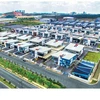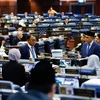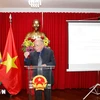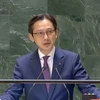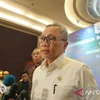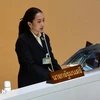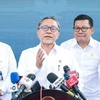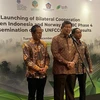Prime Minister Abhisit Vejjajiva of Thailand said that his country’s economic growth on an annual basis has improved, after the implementation of the first and the beginning of the second stimulus package.
According to the Foreign Office of the Government Public Relations Department (PRD), the Prime Minister explained the effects of the stimulus package by the Thai government in his speech at the recent annual meeting of the 2010 OECD-Asian Senior Budget Officials in Bangkok .
PM Abhisit pointed out that, at the beginning of 2009, Thailand faced a contraction of the economy on an annual basis of negative 7.1 percent in the first quarter. His administration, which assumed office at that time, decided to provide the first stimulus package through additional expenditures. The move aimed to quickly aid the national financial strain.
There were programmes including free education, income to support the elderly and training for the unemployed, in addition to quick disbursement, even cash handouts, for low income people.
He stated that the package was launched in March, and by late April, the domestic economy began to recover. At that time, Thailand still suffered from a decline in exports and tourism from 20 to 30 percent on an annual basis.
After it saw positive monthly growth in April and May 2009, the Government decided to introduce the second stimulus package, aimed at investing in infrastructure. This package is now being implemented.
With the two stimulus packages, Thailand has seen growth in the last quarter of 2009 and the beginning of 2010, said PM Abhisit, who was confident that Thailand would achieve an estimated 4 percent growth in the GDP this year.
The Prime Minister also said that Thailand could reduce unemployment. In the beginning of 2009, the country’s unemployment stood at around 800,000 people and then dropped to roughly 400,000. Currently the unemployment rate in Thailand is about 1 percent, which is considered very low.
Once the Government sees signs of private investment recovery, it will begin to scale back some of the planned expenditure in its stimulus package, he said./.
According to the Foreign Office of the Government Public Relations Department (PRD), the Prime Minister explained the effects of the stimulus package by the Thai government in his speech at the recent annual meeting of the 2010 OECD-Asian Senior Budget Officials in Bangkok .
PM Abhisit pointed out that, at the beginning of 2009, Thailand faced a contraction of the economy on an annual basis of negative 7.1 percent in the first quarter. His administration, which assumed office at that time, decided to provide the first stimulus package through additional expenditures. The move aimed to quickly aid the national financial strain.
There were programmes including free education, income to support the elderly and training for the unemployed, in addition to quick disbursement, even cash handouts, for low income people.
He stated that the package was launched in March, and by late April, the domestic economy began to recover. At that time, Thailand still suffered from a decline in exports and tourism from 20 to 30 percent on an annual basis.
After it saw positive monthly growth in April and May 2009, the Government decided to introduce the second stimulus package, aimed at investing in infrastructure. This package is now being implemented.
With the two stimulus packages, Thailand has seen growth in the last quarter of 2009 and the beginning of 2010, said PM Abhisit, who was confident that Thailand would achieve an estimated 4 percent growth in the GDP this year.
The Prime Minister also said that Thailand could reduce unemployment. In the beginning of 2009, the country’s unemployment stood at around 800,000 people and then dropped to roughly 400,000. Currently the unemployment rate in Thailand is about 1 percent, which is considered very low.
Once the Government sees signs of private investment recovery, it will begin to scale back some of the planned expenditure in its stimulus package, he said./.



